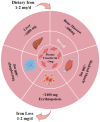Nanodrug Delivery Systems for Myasthenia Gravis: Advances and Perspectives
- PMID: 38794313
- PMCID: PMC11125447
- DOI: 10.3390/pharmaceutics16050651
Nanodrug Delivery Systems for Myasthenia Gravis: Advances and Perspectives
Abstract
Myasthenia gravis (MG) is a rare chronic autoimmune disease caused by the production of autoantibodies against the postsynaptic membrane receptors present at the neuromuscular junction. This condition is characterized by fatigue and muscle weakness, including diplopia, ptosis, and systemic impairment. Emerging evidence suggests that in addition to immune dysregulation, the pathogenesis of MG may involve mitochondrial damage and ferroptosis. Mitochondria are the primary site of energy production, and the reactive oxygen species (ROS) generated due to mitochondrial dysfunction can induce ferroptosis. Nanomedicines have been extensively employed to treat various disorders due to their modifiability and good biocompatibility, but their application in MG management has been rather limited. Nevertheless, nanodrug delivery systems that carry immunomodulatory agents, anti-oxidants, or ferroptosis inhibitors could be effective for the treatment of MG. Therefore, this review focuses on various nanoplatforms aimed at attenuating immune dysregulation, restoring mitochondrial function, and inhibiting ferroptosis that could potentially serve as promising agents for targeted MG therapy.
Keywords: ferroptosis; immunomodulation; mitochondrial dysfunction; myasthenia gravis; nanomedicine.
Conflict of interest statement
The authors have no relevant financial or non-financial interests to disclose.
Figures



References
Publication types
Grants and funding
LinkOut - more resources
Full Text Sources

